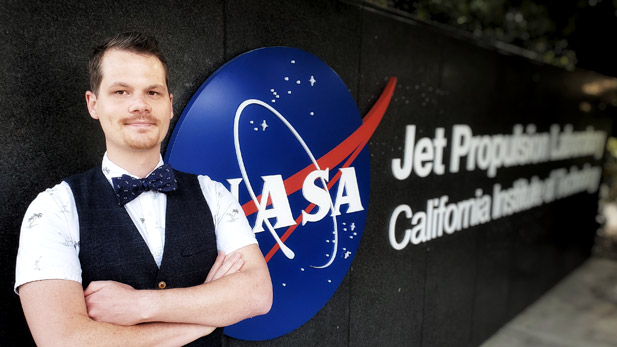Alumni Helping NASA Take a Look Inside Mars & Jupiter

As an ocean world research scientist with NASA, engineering physics alumnus Sam Howell is examining whether the origins of life on the deepest parts of Earth’s ocean floor could unlock mysteries about life on other planets.
Scientists are learning more about the conditions on the planets Mars and Jupiter through research projects assisted by several alumni.
The premise of life underneath a 100-kilometer thick water ice shell on Jupiter’s moon Europa is the focus of research by Sam Howell, who has recently been added to NASA’s Jet Propulsion Laboratory team as an ocean world research scientist. The 2010 engineering physics alumnus is examining whether origins of life on the deepest parts of Earth’s ocean floor could unlock mysteries about the existence of life on other planets and their moons. Underneath Europa is a global salt water ocean that’s 100 kilometers deep.
Howell says, “This is the best candidate for life beyond Earth in the solar system. The thick ice shell shows many of the same processes as plate tectonics on Earth.”
His postdoctoral research centered on assembling computer simulations and statistical models that examine the deformation of geologic materials, through a study of the tectonic plates that are part of the San Andreas plate boundary. This research earned Popular Mechanics’ 2016 Breakthrough Award.
Europa’s thick ice shell shows many of the same processes as plate tectonics on Earth, Howell states. That’s why he is co-leading NASA’s Honeybee robotics collaboration to develop technology to drill through Europa’s ice shell and reach its ocean. He uses computer simulations of the ice and published information to develop system requirements and science observation strategies.
Meanwhile, Thomas Werne is a NASA technical group supervisor at the Jet Propulsion Laboratory and was the flight software lead for the space agency’s recent Mars Cube One (MarCO) project. The two briefcase-sized satellite spacecraft known as “CubeSats” accompanied the space agency’s InSight lander, which touched down on Mars late in 2018. This was the first time CubeSats were used in deep space exploration. Werne stated during the mission, “A big part of MarCo is to prove something like this can be done.”
He has expertise in the development of small spacecraft systems and software systems that assist in the study of space-based data. Werne earned bachelor’s degrees in mathematics and electrical engineering, along with a master’s degree in electrical engineering – all in 2007.
Elsewhere, in JPL’s Systems Engineering and Formulation Division, Dan Dvorak has been improving systems engineering and software architecture for semi-autonomous spacecraft. He 1972 electrical engineering alumnus helped develop early flight software technology for the Mars Science Laboratory, now known as the Curiosity rover that operated on Mars earlier this year.
Dvorak says, “Higher levels of autonomy are increasingly important for deep space missions because round-trip light-time delays can be hours long for the outermost planets in our solar system.”
After starting at NASA/JPL in 1996 Dvorak worked on technology that have made spacecraft, like the Deep Space 1 project, more autonomous and able to complete activities with less intervention from operators on Earth. He also led a NASA study on flight software complexity which led to the creation of the NASA Software Architecture Review Board, which has provided constructive feedback to improve software reliability, verifiability and portability. Dvorak led the review board for several years.